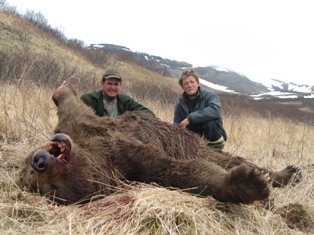Hunt Dates: May 10-25; October 7-21
Coastal Brown Bear hunts occur in spring during even years, and fall during odd years. The spring hunt offers both 10 day and 16 day hunts, and fall hunts are between 10 and 15 days long. These hunts usually book up years in advance, so early booking for these hunts is encouraged. It is important to schedule the travel time into these hunts. You should plan to arrive at least one day before your scheduled bush flight to camp and depart the day following your return from the Bush. These bush flights are often delayed because of weather.
Hunt Location:
The Alaska Peninsula National Wildlife Refuge and the Izembek National Wildlife Refuge
We provide hunts on the The Alaska Peninsula National Wildlife Refuge near Aniakchak National Preserve and also on the Izembek National Wildlife Refuge on the southern tip of the Alaska Peninsula by reference to another outfitter. These National Refuges were created in part to protect these bear populations and waterfowl in the area, and provide some of the finest hunting opportunities in the world. We are the only outfitters allowed to provide guided hunts on these lands.
The Alaskan Peninsula is almost without any tree growth, except for the hardy Alder groves and occasional thickets of willow. The valley bottoms tend to be wet and covered with wild grasses. It is common to have wind and rain storms in this region during our hunts, due to the close proximity of the Bering Sea and North Pacific oceans.
About the Hunt:
You will need to arrive in King Salmon or Cold Bay by commercial flight, after which you will fly will by smaller aircraft to the hunting area. Walking and glassing are the primary means for hunting and stalking from day to day. It is important to note that these hunts oftentimes require patience and careful thought to your movements, since these bears are very sensitive to smell and will oftentimes react to your trail days afterward. When the wind is at your back, you will rarely see a bear in front of you. They are very intelligent and, contrary to myth, have decent eyesight. Add to this the power and endurance of these bears, you soon realize that you are hunting one of the most magnificent creatures on the planet.
In springtime, the bears are emerging from their dens on surrounding hillsides, with male boars emerging first. Hunting consists of selecting suitable places to sit and glassing hillsides and valleys, watching for trophy bears. During this time of the year, bears have a beautiful heavy coat from their long winter hibernation.
In fall, bears are feeding daily on the spawning salmon, recently arrived form saltwater. In the evening, bears come down from the surrounding mountains to the stream-beds and head back up the hillsides in the early morning, so the largest and often wisest bears are often taken at first or last light.
Portions of the Alaska Peninsula have remarkable bear populations due to a very successful management strategy that allows for limited season lengths on alternating years and conservative guide-related harvest levels through Federal guiding concessions. We hunt in the Fall on odd years (2023, 2025, etc.) and our spring hunts are on even years (2024, 2026, etc.)
These National Wildlife Refuges are considered to have the highest bear densities in the world. On one evening alone I watched 60 bears come down to the river for the evening meal in a 3-mile by 5-mile long valley ! This was exceptional however, and it is most normal along the length of the Alaska Peninsula to typically see from 10 to 25 bears on a hunt. It is also possible to hunt waterfowl and fish in these areas.
Costs:
Please see the price list for hunt cost
The prices listed in the price list covers the costs of your guide and all your camping, transportation from King salmon or Cold Bay to the field and back, and trophy preparation needs while you are in the field.
The only other additional expenses you can expect to pay are:
- Your hotel and traveling expenses in Alaska
- The cost of your hunting license and tag fees
- It is normal to provide a tip for your guide at the end of the hunt. This is usually between 5% and 10% of the hunt cost
- The cost of professional preparation of your trophy for customs and transporting your trophy home.



